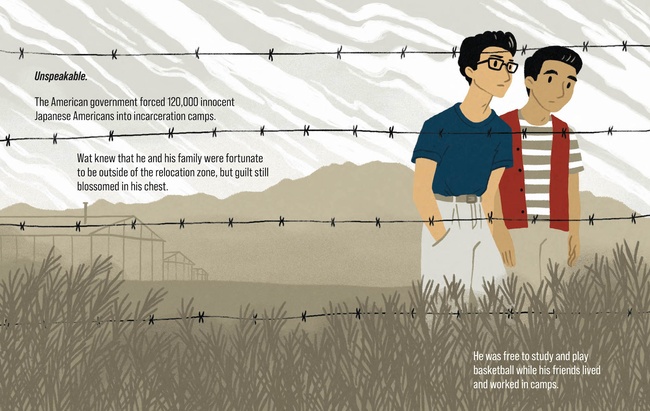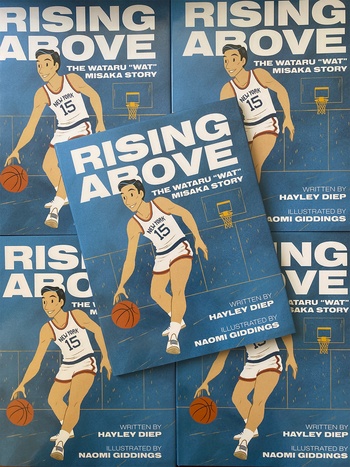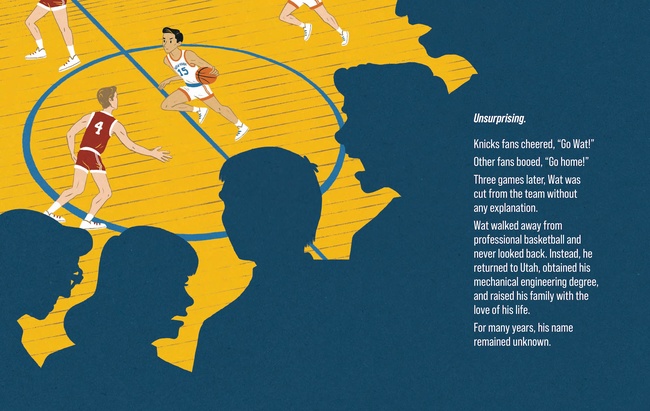Rising Above: The Wataru “Wat” Misaka Story, written by Hayley Diep and illustrated by Naomi Giddings, tells the story of Wataru “Wat” Misaka, a Japanese American who was the first non-Caucasian to play in American professional basketball in 1947.
Wataru Misaka was born in Ogden, Utah in 1923 as a second-generation Japanese American Nisei and would go on to play for Weber College and the Utah Utes, helping win a combined three championships. Wataru Misaka was not incarcerated during World War Two, but was drafted in 1943 in the middle of his college career. Wat returned in 1946 to the Utah Utes and helped the team win their second school championship title in the 1947 NIT Championship.
Misaka joined the New York Knicks that same year in the BAA Draft, now the NBA, and played in three professional basketball games before being cut from the team. Wat then went back to Utah to begin a new career and start a family. Wataru Misaka passed away at the age of ninety-five on November 20, 2019.
Even for basketball fans in the Japanese American community, Wataru Misaka’s significance as the first person to break the color barrier in American professional basketball remains relatively unknown. Yet non-basketball and basketball fans alike can enjoy his story. As a basketball fan myself, I had no knowledge of Wataru Misaka and his legacy of breaking the color barrier in the BAA.
Most will remember Jackie Robinson breaking the color barrier in baseball in 1947, the same year Wataru Misaka broke the color barrier in basketball, yet Misaka’s name is rarely mentioned. Non-basketball will appreciate not only Wataru Misaka’s legacy as a basketball player, but also his role in Japanese American history during this time.
Enduring the hardships and adversity that many Japanese Americans faced during World War II in the United States, Wat’s story remains relevant. Hayley Diep and Naomi Giddings hope that Rising Above will expose more people to the inspiring story of Wataru Misaka and his perseverance in the face of adversity.
Author Hayley Diep and illustrator Naomi Giddings answered our questions about portraying Wataru Misaka’s story and how they came across it.
Cristian Roman (CR): What inspired you to research and write/draw about Wataru Misaka?
Hayley Diep (HD): Before researching Wataru Misaka, I actually had never heard of him before. During the 2021 NBA playoffs, my family was watching a game. As a writer, I’m constantly asking questions, and a lot of my questions lead to my stories. Listening to my family chatter about the basketball game prompted me to wonder: “Who was the first non-White NBA player?” After a quick Google search, I was very surprised to learn that it was Wataru Misaka. I spent the rest of the evening learning more about Wat Misaka’s life and journey into the NBA, then known as the BAA.
Learning about Wat stirred a lot of varying emotions within me: pride, hope, sadness, anger, joy. I grew up never seeing Asian Americans playing professional sports. I grew up surrounded by people and the media who negatively stereotyped Asian American men. I felt like Wat Misaka upended a lot of those stereotypes and shed a light on the fact that Asian Americans can play sports successfully at the collegiate level and enter professional sports, regardless of how unfairly others may view or treat them.
I wanted to write Wat’s story because I believed that his story had gone unseen for far too long. Growing up as an Asian American, I don’t think I ever realized how unseen I felt until I learned about Wat. So much of our schooling and society doesn’t ever discuss the impacts of historical events on Asian Americans, and it hardly ever highlights Asian American heroes. I wanted to write this book so that other kids could learn about Wat, his accomplishments, and how he overcame adversity and discrimination by simply playing a sport he loved and staying true to himself.
Naomi Giddings (NG): Although I’d never heard of Wataru Misaka before this project, I found one person in my life who had—my grandfather, who not only knew his name but remembered following his career back in the 1940s via the Japanese American papers of the time. It was so valuable to hear about his memories of Misaka’s fame within the JA community and the ways he served as a beacon of hope to JAs like my grandfather who were imprisoned during WWII in American incarceration camps. Although my grandfather died before this book came out, I’m so grateful I had the opportunity to speak with him about this project and Misaka’s legacy. My work was heavily influenced by the desire to keep Misaka's legacy alive for both my grandfather’s generation and those that come after, both within and beyond the JA community.
CR: How much would you say your background (cultural/ethnic) has influenced your work/this work?
HD: I don’t know if my background influenced this work, but I think it was a major reason why I started writing this work.
NG: As a Yonsei (fourth-generation Japanese American), it was very important to me that this project honor both Misaka’s memory and the larger JA community. I was raised on stories of my family members’ experiences in the Japanese American concentration camps of WWII, so it was important to me that my illustrations for this picture book depicted the camps in a thoughtful way. I also spent a lot of time finding ways to add visuals that felt Japanese American—it was fun to include details like showing Misaka’s family eating a familiar JA dish, or depicting objects and patterns that I grew up seeing in my own family home.
CR: Were there any difficulties/setbacks or certain areas of interest over the course of working on this project?
HD: Whenever I write a nonfiction piece, I’m always very concerned by how accurately I am conveying the story, especially since writing is artistic and I’m writing it from my lens. With Rising Above, in particular, I was very concerned about capturing Wat’s story as authentically as possible.
Also, while I am Asian American, I am not Japanese American, and I was worried that perhaps I was not capturing the nuances of being Japanese American well enough with this book. There was also always the question of whether or not I was the right person to tell this story lingering in the back of my mind, but I tried my best to do my due diligence, be open-minded, and be truthful, because I truly wanted people to learn about Wat’s story.
NG: One of the most challenging and interesting aspects of this project for me was the historical, real-world nature of the story. I spent a lot of time trying to find factual details to include in my illustrations, and consulted many people to make sure I could be as accurate as possible. I’m indebted to the Misaka and Johnson families for their valuable insight into Misaka’s life, as well as multiple colleagues, family, and friends for providing their knowledge on topics like Misaka’s hometown, Nikkei history, and the 1940s military. I also owe thanks to resources like the Densho Project for providing me with information about a variety of topics relevant to this book such as the Topaz Relocation Center and 1940s fashion.

CR: Anything to say or comment on with the role that sports play in minority communities (or just the role that sports has played in your own life)?
HD: I grew up with NBA games constantly playing in the background of my home and my grandparents’ homes. My entire immediate and extended family have always been zealous Lakers fans, and basketball in particular has always been a source of comfort and form of connection for us. We loved shooting hoops outside on the weekends and screaming at the TV whenever the Lakers won a close game. Even to this day, watching a Lakers game takes me back to evenings when my cousins and I were jam packed into a living room with all of our aunts, uncles, and grandparents.
(I don’t think I can speak to the role that sports play in minority communities. But I do think that in general, sports are so unique and powerful in the sense that they can bring people together and foster a sense of belonging amongst fellow fans).
NG: I think it’s really fascinating how sports have the opportunity to level the playing field for marginalized communities—while money and privilege definitely provide a leg up in any industry, there’s something to be said for the way sports oftentimes serve as an entrypoint for talented individuals into previously segregated spaces. It’s worth noting that Misaka’s NBA career began the same year Jackie Robinson joined the MLB, and while Misaka may have been the first person of color admitted to the NBA, he was not the only athlete of color in basketball at the time—the Harlem Globetrotters were active for several decades prior, but none were admitted to the NBA because of their skin color.
There’s an interesting conversation to be had about the model minority myth and anti-Blackness, as well as solidarity between Black, Asian, and other people of color in the USA. Sports can serve as both a mirror and a model of our society and its values, and that’s one of the reasons stories about trailblazing athletes can resonate so deeply.
All images provided courtesy of Naomi Giddings.
© 2024 Cristian Roman









